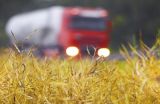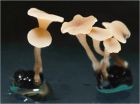(Press-News.org) Histones are proteins needed to assemble DNA molecules into chromosomes. They have long represented a classic balancing act in biology; too few histone molecules result in DNA damage, while too many histones are toxic to the cell. New research at the University of Rochester is causing a fundamental shift in the concept of histone balance and the mechanism behind it.
Previous studies of Drosophila embryos showed massive amounts of histones located on lipid droplets, the structures associated with fat storage. While it had been speculated that the lipid droplets provide a place for safe, temporary storage of the histones, scientists had no clear proof for this storage idea nor did they understand how the histones attached to the surface of the droplets.
"What we discovered is that the lipid droplets serve as a holding space, making the histones available for the formation of chromosomes at the precise time they're needed," said Associate Professor of Biology Michael Welte. "We also found that when there are no lipid droplet-bound histones in the embryo, there are problems with the structure of chromosomes that can lead to death."
Welte and his research team were able to come to these conclusions by identifying the protein called "Jabba" as the specific molecule that anchors histones onto the surface of the lipid droplets.
The other scientists on the research team were Zhihuan Li in Rochester, and Katharina Thiel, Peter Thul, Mathias Beller and Ronald Kühnlein in Germany. Their work will be published next month in the journal Current Biology.
Histones not bound to DNA have long been considered toxic, prompting them to be destroyed by the cells. Welte's work demonstrates that binding to lipid droplets protects the histones, while storing them for later use in chromosome assembly.
Since there is evidence that histones and other proteins are associated with lipid droplets in a variety of organisms, including humans, Welte believes there may be medical relevance in the future.
"We've shown that lipid droplets have a function beyond fat metabolism, and it raises the possibility that, in some cases, fat storage may be beneficial," said Welte. "Additional lipid droplets may allow more toxic proteins to be sequestered, thus protecting the organism."
The next step for Welte and his lab is to determine how Jabba attaches the histones to the lipid droplets and how the binding is regulated. Welte also wants to know if proteins other than histones are being sequestered on the droplets for future use by the Drosophila embryo.
INFORMATION: END
To transport substances from the site of their production to their destination, the body needs a sophisticated transport and sorting system. Various receptors in and on the cells recognize certain molecules, pack them and ensure that they are transported to the right place. One of these receptors is Sortilin. It is present in the cells of the nervous system, the liver, and the immune system. Studies by Stefanie Herda and Dr. Armin Rehm (Max Delbrück Center for Molecular Medicine, MDC, Berlin-Buch and Charité–Universitätsmedizin Berlin) and the immunologist Dr. Uta Höpken ...
Braunschweig/ Leipzig. An interdisciplinary team of 11 scientists from seven European countries and the USA have discussed the concept to utilize so called surplus land for the production of feedstock for bioenergy. They identified environmental, economic and social constraints but also options for efficient use of surplus land for bioenergy. The study provides a scientific background in support of a reassessment of land available for bioenergy feedstock production. Their findings were published in the open access journal BioRisk.
Increasing demand for bioenergy feedstock ...
A newly released IOF report for World Osteoporosis Day, 'Capture the Fracture – A global campaign to break the fragility fracture cycle', clearly outlines the care gap which is leaving millions of fracture patients undiagnosed and without treatment for osteoporosis or assessment for falls risk.
IOF CEO Judy Stenmark stated, "An adult who has experienced a first fragility fracture – often at the wrist or vertebrae – is at double the risk of having a fracture as compared to someone who hasn't fractured. Despite this red flag indicating osteoporosis and high risk of subsequent ...
WHAT:
When tested in patients hospitalized with extensively drug-resistant tuberculosis (XDR-TB) unresponsive to previous treatment, linezolid, an antibiotic used to treat severe bacterial infections, proved largely effective when added to the patients' ongoing TB treatment regimen. Also, few patients developed resistance to the drug. These promising findings were tempered, however, by the fact that 82 percent of the patients who received linezolid experienced significant adverse events that may have been related to the drug. Findings from the study appear in the ...
PULLMAN, Wash. - A Washington State University researcher has found that engaging elementary school students in science for as little as 10 hours a year can lead to improved test scores in math and language arts.
Samantha Gizerian, a clinical assistant professor in WSU's Department of Veterinary and Comparative Anatomy, Pharmacology and Physiology, saw improved test scores among fourth-grade students in South Los Angeles after students from the Charles R. Drew University of Medicine and Science gave 10 one-hour presentations on science.
"A lot of students say things like, ...
UNIVERSITY OF CALIFORNIA, BERKELEY'S HAAS SCHOOL OF BUSINESS –The last few months leading up to an election can be a critical, political game changer. One right or one wrong move can quickly change a candidate's standing at the polls. New research suggests that judges who are elected, rather than appointed, respond to this political pressure by handing down more severe criminal sentences – as much as 10 percent longer –in the last three months before an election compared with the beginning of their terms.
"We can't say if more severe sentencing is better for society or ...
Non-infected babies born to HIV positive mothers should be vaccinated early against measles, to avoid them acquiring the virus or passing it on to others.
A study published in the November issue of Acta Paediatrica found that even if babies are born without HIV, their maternally derived protection against measles may be impaired by their mother's positive HIV status.
"The eradication of measles is high on the agendas of the World Health Organization and other international agencies and it is important to define and target any new group of susceptible infants" says ...
Almost 500 international experts have worked together to develop a ranking system of the ten most important phytopathogenic fungi on a scientific and economic level. The rice blast fungus (Magnaporthe oryzae) sits at the top of the list.
A survey conducted on 495 international researchers resulted in a list contaning the most important phytopathogenic fungi. Each researcher chose three that they thought to be most significant and the most voted then formed the list.
Said list has been published in the journal Molecular Plant Pathology and each one of the species mentioned ...
Researchers at the University of Leeds have identified a crucial stage in the lifecycle of simple viruses like polio and the common cold that could open a new front in the war on viral disease.
The team are the first to observe at a single-molecule level how the genetic material (genome) that forms the core of a single-strand RNA virus particle packs itself into its outer shell of proteins. Lead researcher Professor Peter Stockley said their results overturn accepted thinking about the process and could open a chink in the armour of a wide range of viruses.
"If we can ...
UK scientists hope that lymphoma patients could benefit from a new drug that triggers the cancer-fighting properties of the body's own immune system, after highly promising early laboratory results.
The University of Manchester researchers, who were funded by the charity Leukaemia & Lymphoma Research, have shown that, when used in conjunction with radiotherapy, the new drug is potentially four times more likely to lead to long-term survival than radiotherapy alone.
Relapse is a common fate for many lymphoma patients and new treatments are desperately needed. The new ...

